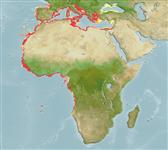Environment: milieu / climate zone / depth range / distribution range
Écologie
marin démersal; profondeur 15 - 200 m (Ref. 5222), usually 15 - 50 m (Ref. 2683). Subtropical; 43°N - 16°S, 20°W - 38°E (Ref. 5222)
Eastern Atlantic: Portugal to southern Angola; reports from islands require confirmation. Specimens from Madeira, Azores, Canary Islands, and Cape Verde have been examined by Heemstra (1991, Ref. 6512) and are identified to be Mycteroperca fusca. Replaced by Mycteroperca acutirostris in the western Atlantic.
Length at first maturity / Taille / Poids / Âge
Maturity: Lm 34.0, range 32 - 36 cm
Max length : 144 cm TL mâle / non sexé; (Ref. 40637); common length : 80.0 cm TL mâle / non sexé; (Ref. 2683); poids max. publié: 49.7 kg (Ref. 40637)
Description synthétique
Clés d'identification | Morphologie | Morphométrie
Épines dorsales (Total) : 11; Rayons mous dorsaux (Total) : 15 - 17; Épines anales: 3; Rayons mous anaux: 11 - 12. Distinguished by the following characteristics: usually reddish brown, sometimes mottled with black or pale grey spots with black streak above maxilla; juveniles with black saddle blotch on peduncle; oblong body, compressed, depth contained 2.8-3.2 times in SL; head length 2.5-2.7 in SL; convex interorbital area; enlarged serrae at angle of preopercle, forming rounded lobe set off by the indentation immediately above; nostrils subequal in juveniles, posterior nostrils about twice that of anterior ones in adults (Ref. 89707).
Occurs over rocky and sandy bottoms; young individuals very common in mangrove-lined lagoons. Feeds on mollusks (presumably cephalopods) and small fishes (Ref. 89707). Marketed fresh.
Life cycle and mating behavior
Maturité | Reproduction | Frai | Œufs | Fécondité | Larves
Heemstra, P.C. and J.E. Randall, 1993. FAO Species Catalogue. Vol. 16. Groupers of the world (family Serranidae, subfamily Epinephelinae). An annotated and illustrated catalogue of the grouper, rockcod, hind, coral grouper and lyretail species known to date. Rome: FAO. FAO Fish. Synop. 125(16):382 p. (Ref. 5222)
Statut dans la liste rouge de l'IUCN (Ref. 130435: Version 2024-2)
Menace pour l'homme
Harmless
Utilisations par l'homme
Pêcheries: intérêt commercial mineur
Outils
Articles particuliers
Télécharger en XML
Sources Internet
Estimates based on models
Preferred temperature (Ref.
123201): 15.3 - 27.4, mean 19.4 °C (based on 296 cells).
Phylogenetic diversity index (Ref.
82804): PD
50 = 0.5000 [Uniqueness, from 0.5 = low to 2.0 = high].
Bayesian length-weight: a=0.01072 (0.00685 - 0.01675), b=3.01 (2.88 - 3.14), in cm total length, based on LWR estimates for this species & Genus-body shape (Ref.
93245).
Niveau trophique (Ref.
69278): 4.1 ±0.58 se; based on food items.
Generation time: 10.4 ( na - na) years. Estimated as median ln(3)/K based on 1
growth studies.
Résilience (Ref.
120179): Très faible, temps minimum de doublement de population supérieur à 14 ans (Preliminary K or Fecundity.).
Fishing Vulnerability (Ref.
59153): High to very high vulnerability (67 of 100).
Nutrients (Ref.
124155): Calcium = 34.6 [15.2, 67.1] mg/100g; Iron = 0.82 [0.44, 1.54] mg/100g; Protein = 18.6 [16.6, 20.2] %; Omega3 = 0.331 [0.208, 0.544] g/100g; Selenium = 40.9 [19.7, 83.1] μg/100g; VitaminA = 13.4 [4.2, 49.3] μg/100g; Zinc = 0.474 [0.334, 0.700] mg/100g (wet weight);
